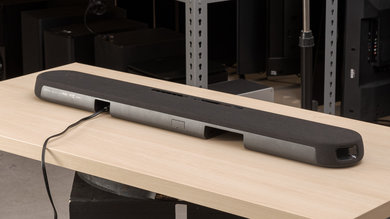Our Verdict
Okay for mixed usage. The Yamaha ATS-1080 has an okay audio reproduction that will be suitable for most music genres and dialogue content like podcasts and audiobooks. However, its bass isn't extended, which won't be great for movies and bass-heavy music. It also has sub-par performance with surround channels and doesn’t support height channels, resulting in a less immersive listening experience. Also, its soundstage isn’t that wide, and it will downmix 5.1 surround content down to stereo.
- Good connectivity options.
- Decent for dialogue-oriented content.
- Performs well at max volume.
- Cheap fabric-covered design.
- Lacks sub-bass.
- Downmixes surround content to stereo.
Passable for dialogue and TV shows. The Yamaha YAS-108 has a good mid-range performance, which results in accurate voices, but its overall sound profile is dark as it lacks detail in the treble range. It will get loud enough for most content and you’ll be able to easily stream podcasts and audiobooks via Bluetooth. The bar also has a dialogue enhancement feature to help make dialogue clearer, even at lower volumes.
Okay for music. The Yamaha ATS1080 doesn’t have the best bass performance as it lacks a lot of sub-bass, meaning it won’t be great for bass-heavy music. Its overall sound profile is also fairly dark and the soundstage is narrow. On the upside, it gets loud and performs quite well at max volume, and you’ll be able to play music via Bluetooth with your smart device, but you won’t be able to EQ the sound to your liking.
Mediocre for movies. The Yamaha YAS-108 has a decent overall audio reproduction, but it doesn’t do well with surround channels. On top of that, the soundstage isn’t that wide and the bar doesn’t have height channels and doesn’t support Atmos. All of this will result in a less immersive listening experience. This 2.2 setup will downmix 5.1 content and won’t sound as real as other high-end setups. You can use its surround mode to help a bit, but the audio quality won’t be the greatest.
Changelog
- Updated Dec 04, 2023: Added market comparison with the Yamaha ATS-1090 in the Voice Assistants Support box.
- Updated Dec 10, 2021: Added third-party voice assistant compatibility.
- Updated Apr 01, 2021: Converted to Test Bench 1.0.
- Updated Sep 27, 2019: Review published.
Check Price
Popular Soundbar Comparisons
The Yamaha ATS-1080 is a unique soundbar that has two built-in subwoofers, which results in a fairly dark sound profile. However, it doesn't have the good bass performance of a dedicated subwoofer like other budget soundbars. See our recommendations for the best soundbars, the best budget soundbars, and the best soundbars with a subwoofer.
The Yamaha YAS-109 is the next generation of the Yamaha YAS-108/ATS-1080. The YAS-109 has an Ethernet port instead of an AUX port, it supports wireless playback via Wi-Fi, and it also has EQ presets. However, the YAS-108 can get a bit louder with fewer compression artifacts.
The standalone Sonos Arc is better than the Yamaha YAS-108/ATS-1080. The Sonos is a 5.0.2 setup that's better built and offers better soundstage, center, and surround performances. It reproduces a more extended low-bass, too. Unlike the Yamaha, it supports Atmos content and has built-in voice assistant support. There are even more sound enhancement features, such as room correction.
The Yamaha YAS-108/ATS-1080 has been discontinued, but its performance is similar to that of the Yamaha ATS-1090. They're both 2.2 soundbars with similar designs. The 1080 brings a little more bass, and it gets louder. However, it doesn't support Alexa or Wi-Fi connectivity like the 1090.
The Sonos Beam is a slightly better-performing soundbar than the Yamaha YAS-108/ATS-1080. The Sonos has a more extended bass, feels better built, and offers more sound enhancement features. On the other hand, the Yamaha has more connectivity options, including a Full HDMI In port. The Yamaha also has Bluetooth playback, while the Sonos can only connect via Wi-Fi or Apple AirPlay.
Test Results

The bar isn't too wide and depending on the stand of a 55" TV, it might or might not fit in-between the legs. It's not too tall and won't obstruct the view of the bottom side of the screen unless your TV has a very short stand or sits flush on the table.
The Yamaha ATS-1080 has an okay stereo frequency response. This soundbar doesn’t have a very extended bass and so has a bit of difficulty recreating the deep punch and rumble of movies and music. This might be because it doesn’t have a wireless subwoofer, but rather two built-in subs. On the upside, the mid-range is well-balanced and results in an accurate reproduction of voices. The overall sound profile is a bit dark due to the lacking detail in the treble.
When listening to the Yamaha ATS-1080, the soundstage isn’t that great. The soundstage seems to be as wide as the bar and the ATS1080 doesn’t do anything to make it sound wider. The soundstage sounds fairly focused, but the dark frequency response makes sounds come from a small general area rather than a very accurate pinpoint location like some other soundbars.
The Yamaha ATS-1080 has great dynamics performance. The bar can get loud enough for most uses and will be a good option in crowded environments or large rooms. Also, the bar doesn’t compress at max volume, which is great.
The THD performance of this soundbar is great. At a normal listening volume, the Yamaha ATS-1080 reproduces a clean and pure sound, but there’s a big jump in THD at max volume, throughout the range. However, most people will have trouble hearing this with real-life content.
This 2.2 setup doesn’t have a dedicated center channel, which results in poor center localization, but still has an okay performance. It uses the left and right speakers to create a sound in the center, which will sound more diffused and less clear compared to a discrete center. Also, due to its configuration, this soundbar will downmix 5.1 content. On the upside, the mid-range is still fairly good and dialogue in movies is clear.
The Yamaha ATS1080's performance when sending surround content to the soundbar is quite poor. Everything is downmixed to a stereo signal, which won’t produce an accurate and clear representation of surround objects. This means the result isn’t very immersive and the objects are perceived to come from the front instead of the sides or behind you.
The Yamaha YAS-108 setup doesn’t have height channels and doesn’t support Atmos.
The Yamaha ATS1080 has poor sound enhancement features. It's missing Room Correction, which means this soundbar may sound differently depending on your room. There's also no Auto-Volume/Night Mode, so it can't normalize the sound between types of content like a TV show and the sound level of a commercial. On the upside, it supports dialogue enhancement features to help you hear the dialogue better and more clearly, even at lower volumes. You can also separately adjust the level of the subwoofer, which is useful considering that the two built-in subwoofers don’t perform that well. Although the bar has a 3D surround mode, the sound quality isn't the best when using it. You'll be better off using the normal surround mode, which doesn't sound as bad.
The Yamaha ATS-1080 has a good set of inputs. The Optical Audio In can deliver surround sound, while the Full HDMI In and HDMI ARC can be used to relay video signals from your games consoles or Blu-rays to your TV, enhancing both your sound and visual experiences. The soundbar also offers a plain Audio In 3.5mm for direct connection to the Audio out jack of older devices with limited connectivity. Finally, there's a 'Subwoofer Out' port allowing you to connect to an external subwoofer with an RCA mono cable, to enhance your bass experience. Unfortunately, there's no ethernet port for connecting to your network, or a USB port to play music from a USB key.
Over the HDMI ARC, the soundbar supports only the most common Dolby Digital and DTS formats. It can decode 5.1 surround sound from streaming platforms or Blu-ray discs, but downmixes it to 2.2 due to its configuration. Unfortunately, you won’t be able to play lossless or object-based formats via HDMI ARC, but you can connect through the Full HDMI In, to playback uncompressed 5.1 PCM audio.
The Yamaha ATS-1080 can playback surround sound that's encoded in Dolby Digital or DTS formats when the signal is received through its Full HDMI in port. It can also decode 5.1 PCM uncompressed sound which will also downmix to 2.2 just like all other surround signals. Unfortunately, you won't be able to experience any object-based surround sound as there's no support for such formats with this bar.
The Yamaha ATS1080's optical port supports both Dolby Digital and DTS. Dolby Digital is usually found on Blu-ray discs and streaming platforms like Netflix. DTS isn't so common on its own, but rather as the fallback of the higher quality DTS-HD MA commonly found on Blu-ray discs. When playing back surround sound, the ATS 1080 downmixes it to 2.2.
The Yamaha ATS-1080 allows you to play content wirelessly through its Bluetooth connection. This is great for connecting your smartphone or tablet, but in the absence of that, you won't be able to connect to the Wi-Fi or cast using Chromecast built-in or AirPlay. If you're looking for a Yamaha soundbar that supports Wi-Fi, try the Yamaha YAS-109/ATS-1090.
You can place the Yamaha ATS-1080 in-between one of your devices like a PC or a gaming console and your TV. If you do so, the soundbar can send proper 4k @ 60Hz @ 4:4:4 which means that you'll enjoy crystal clear text. It also supports HDR10 passthrough, which is great if you have a Blu-ray player or one of the newer gaming consoles.
This soundbar doesn't have built-in voice assistant support like the Yamaha ATS-1090. However, the manufacturer says you can use it with a third-party Amazon Alexa device. You just have to set it up in the Amazon Alexa app.
The Yamaha ATS-1080 pairs with the same app as the YAS-207. It's a fairly basic app that offers most of the remote's features, but is missing functions like the home theater controller. It doesn't allow you to cast audio files directly to the soundbar.



































